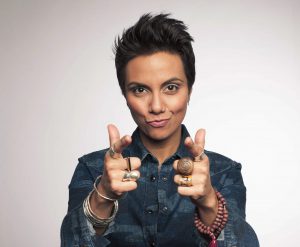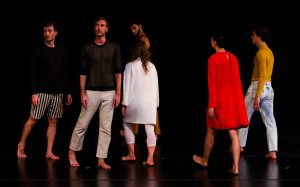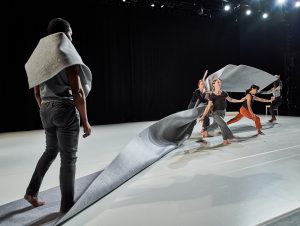“As the landscape of America is changing, this type of conversation becomes more important and relevant. People need to be able to feel like they’re complicated.”
— Usama Alshaibi for the Chicago Reader
I first learned about the cinematic essay from the late Peter Thompson, a photo and documentary professor at Columbia College Chicago. His films, Universal Hotel and Universal Citizen were part of the MFA curriculum, but his documentary editing class was an elective. Taking that class with some of my dear friends turned my filmmaking process on its head and led to my current project, a web-series entitled My Father’s Knee.
My Father’s Knee ties the story of my father and I to the struggle for immigration reform. It’s about my attempts to reconcile the difference between the life he wanted for me and the one I made instead, and the difference between the ideals set out by this nation and the way it actually functions. In Thompson’s class, I discovered the poetry of non-fiction in its ability to weave single threads of truth into more intricate portraits. What I remember most about him is the way he’d count time as he watched an edit, letting his past experience as a composer influence they way he tells a story. It encouraged me to integrate more of myself into my work, something that I saw as taboo at the time.
Peter’s self-reflexive documentary style is an evolution of the informal essay, which rejects the idea that essays should be rigid and void of personal experience or opinion. Mirroring the work of such authors as Hunter S. Thompson and Truman Capote, the cinematic essay is subjective, flexible and self-critical. Free from narrative boundaries, it offers the filmmaker an opportunity to disregard plot to better focus on a theme. I agree with Thompson that “cinematic essay is perhaps the most exciting genre in contemporary film” because the intimacy of an introspective point of view can feel dangerous, like peering into someone else’s eyes or hearing about their deepest insecurities.
It’s a risky form of storytelling because of the responsibility it puts on the audience to understand the world as you’re presenting it. Thompson calls this “suspension of belief,” the opposite of the suspension of disbelief that conventional cinema demands. It invites the viewer to question the motive of the director by calling attention to the boundaries between truth and fiction while blurring the lines between documentary, narrative, and experimental film.
I love the form because it embraces failure so gracefully. “Flirting with failure is in the origin of the very word,” wrote Thompson on his portfolio site Chicago Media Works. “Essai, from essayer— to attempt, to try–and not necessarily to succeed.” The odds of convincing someone that your life or point of view merits an entire film are slim. I’ve even heard personal documentary described as an arrogant or vain endeavor. Some even imply the story could be told with more honesty by someone that could look at it objectively. My view is that there’s no story that I can tell better on my own, no one knows my story as well as I do and no one’s going to tell my story if I don’t tell it.
There’s an element of arrogance involved in my quest, but my reason for making cinematic essays isn’t that my story is unique. Instead, I’m afraid that my story is all too common. Young people today are just as hungry for stories that echo their experience as I was in my youth. I recently attended a screening of American Arab by Iraqi-American Usama Alshaibi at the Chicago Underground Film Festival, and I found it was a story that reflected my own youthful experiences. Growing up in Iowa, Alshaibi struggled to form an identity between his home culture and middle America. The prejudices we faced are different, but we share many of the same battle scars.
In the Q&A after the film, Usama said that he set out to make a film about the Iraqi-American experience but ended up making one about the American experience. He also attributed the popularity of personal documentaries the America’s demographic shift and increasing accessibility to digital storytelling tools. The bravery it took for Usama to publicly display his cultural maturation encouraged me to continue moving forward with my project despite the inherent risks in the format of the cinematic essay. He was also part of a diversity fellowship through Kartemquin Films that paved the way for documentary filmmakers of color in Chicago and the midwest.
I participated in Diverse Voices in Docs last year, a program that grew out of Usama’s experience with Kartemquin. I developed a pilot episode for My Father’s Knee through the program and pitched it to representatives of a few prestigious documentary funders. One that I was particularly intrigued by was from The Illinois Humanities Council, who told me that films like mine weren’t in their wheelhouse because its biographical and anchored in personal experience. She told me that getting funding from them wasn’t impossible but it would be an uphill battle. Seeing them among the list of funders on film like American Arab tells me that Alshaibi scaled that mountain. It’s been done before and it can be done again. As he says in an interview for the Chicago Reader, “it’s our responsibility to change the visual landscape.” I couldn’t agree more.
 Mario is a co-founder of The Contreras-Gabriel Project, a trans-media platform for the mutual benefit of artists and audiences. His documentary work centers on the Chicano experience in the Midwest but he also experiments with photography, printmaking, gardening and any other medium that suites his purposes.
Mario is a co-founder of The Contreras-Gabriel Project, a trans-media platform for the mutual benefit of artists and audiences. His documentary work centers on the Chicano experience in the Midwest but he also experiments with photography, printmaking, gardening and any other medium that suites his purposes.


